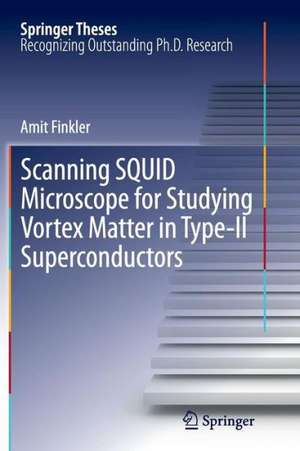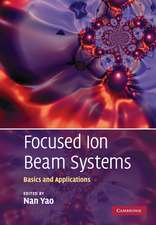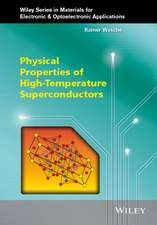Scanning SQUID Microscope for Studying Vortex Matter in Type-II Superconductors: Springer Theses
Autor Amit Finkleren Limba Engleză Paperback – 11 iun 2014
| Toate formatele și edițiile | Preț | Express |
|---|---|---|
| Paperback (1) | 629.74 lei 6-8 săpt. | |
| Springer Berlin, Heidelberg – 11 iun 2014 | 629.74 lei 6-8 săpt. | |
| Hardback (1) | 634.32 lei 6-8 săpt. | |
| Springer Berlin, Heidelberg – 18 mai 2012 | 634.32 lei 6-8 săpt. |
Din seria Springer Theses
- 18%
 Preț: 997.88 lei
Preț: 997.88 lei -
 Preț: 389.88 lei
Preț: 389.88 lei - 15%
 Preț: 646.94 lei
Preț: 646.94 lei - 18%
 Preț: 943.43 lei
Preț: 943.43 lei -
 Preț: 399.29 lei
Preț: 399.29 lei - 18%
 Preț: 944.99 lei
Preț: 944.99 lei - 15%
 Preț: 636.80 lei
Preț: 636.80 lei - 18%
 Preț: 941.05 lei
Preț: 941.05 lei - 15%
 Preț: 643.16 lei
Preț: 643.16 lei - 15%
 Preț: 642.68 lei
Preț: 642.68 lei - 18%
 Preț: 1103.62 lei
Preț: 1103.62 lei - 20%
 Preț: 558.83 lei
Preț: 558.83 lei - 18%
 Preț: 1112.30 lei
Preț: 1112.30 lei - 18%
 Preț: 944.19 lei
Preț: 944.19 lei - 18%
 Preț: 1109.92 lei
Preț: 1109.92 lei - 18%
 Preț: 1217.27 lei
Preț: 1217.27 lei - 15%
 Preț: 640.06 lei
Preț: 640.06 lei - 15%
 Preț: 636.45 lei
Preț: 636.45 lei - 15%
 Preț: 640.06 lei
Preț: 640.06 lei - 15%
 Preț: 640.88 lei
Preț: 640.88 lei -
 Preț: 389.70 lei
Preț: 389.70 lei - 20%
 Preț: 563.91 lei
Preț: 563.91 lei -
 Preț: 393.35 lei
Preț: 393.35 lei - 15%
 Preț: 637.93 lei
Preț: 637.93 lei - 15%
 Preț: 641.85 lei
Preț: 641.85 lei - 18%
 Preț: 1225.94 lei
Preț: 1225.94 lei - 20%
 Preț: 551.36 lei
Preț: 551.36 lei - 18%
 Preț: 1229.10 lei
Preț: 1229.10 lei - 15%
 Preț: 639.25 lei
Preț: 639.25 lei - 18%
 Preț: 999.45 lei
Preț: 999.45 lei - 15%
 Preț: 640.06 lei
Preț: 640.06 lei - 18%
 Preț: 1220.45 lei
Preț: 1220.45 lei - 18%
 Preț: 1116.26 lei
Preț: 1116.26 lei - 18%
 Preț: 1110.72 lei
Preț: 1110.72 lei - 18%
 Preț: 1000.87 lei
Preț: 1000.87 lei - 18%
 Preț: 891.17 lei
Preț: 891.17 lei - 15%
 Preț: 640.06 lei
Preț: 640.06 lei - 5%
 Preț: 1154.07 lei
Preț: 1154.07 lei - 15%
 Preț: 635.96 lei
Preț: 635.96 lei - 15%
 Preț: 640.88 lei
Preț: 640.88 lei -
 Preț: 387.20 lei
Preț: 387.20 lei - 18%
 Preț: 1109.92 lei
Preț: 1109.92 lei -
 Preț: 385.25 lei
Preț: 385.25 lei -
 Preț: 385.25 lei
Preț: 385.25 lei - 18%
 Preț: 1112.30 lei
Preț: 1112.30 lei - 18%
 Preț: 999.45 lei
Preț: 999.45 lei -
 Preț: 386.99 lei
Preț: 386.99 lei - 15%
 Preț: 637.13 lei
Preț: 637.13 lei - 20%
 Preț: 554.21 lei
Preț: 554.21 lei - 20%
 Preț: 555.59 lei
Preț: 555.59 lei
Preț: 629.74 lei
Preț vechi: 740.87 lei
-15% Nou
Puncte Express: 945
Preț estimativ în valută:
120.50€ • 128.86$ • 100.47£
120.50€ • 128.86$ • 100.47£
Carte tipărită la comandă
Livrare economică 18 aprilie-02 mai
Preluare comenzi: 021 569.72.76
Specificații
ISBN-13: 9783642431524
ISBN-10: 3642431526
Pagini: 76
Ilustrații: XIV, 62 p.
Dimensiuni: 155 x 235 x 4 mm
Greutate: 0.12 kg
Ediția:2012
Editura: Springer Berlin, Heidelberg
Colecția Springer
Seria Springer Theses
Locul publicării:Berlin, Heidelberg, Germany
ISBN-10: 3642431526
Pagini: 76
Ilustrații: XIV, 62 p.
Dimensiuni: 155 x 235 x 4 mm
Greutate: 0.12 kg
Ediția:2012
Editura: Springer Berlin, Heidelberg
Colecția Springer
Seria Springer Theses
Locul publicării:Berlin, Heidelberg, Germany
Public țintă
ResearchCuprins
Introduction.- Scientific Background.- Open Questions.- Goal.- Methods.- SQUID-on-tip Fabrication.- Tuning Fork Assembly.- Scanning SQUID Microscopy.- Fabrication of Samples.- Results.- SQUID-on-tip Characterization.- Imaging.- Discussion.- Appendices.
Textul de pe ultima copertă
Common methods of local magnetic imaging display either a high spatial resolution and relatively poor field sensitivity (MFM, Lorentz microscopy), or a relatively high field sensitivity but limited spatial resolution (scanning SQUID microscopy). Since the magnetic field of a nanoparticle or nanostructure decays rapidly with distance from the structure, the achievable spatial resolution is ultimately limited by the probe-sample separation. This thesis presents a novel method for fabricating the smallest superconducting quantum interference device (SQUID) that resides on the apex of a very sharp tip. The nanoSQUID-on-tip displays a characteristic size down to 100 nm and a field sensitivity of 10^-3 Gauss/Hz^(1/2). A scanning SQUID microsope was constructed by gluing the nanoSQUID-on-tip to a quartz tuning-fork. This enabled the nanoSQUID to be scanned within nanometers of the sample surface, providing simultaneous images of sample topography and the magnetic field distribution. This microscope represents a significant improvement over the existing scanning SQUID techniques and is expected to be able to image the spin of a single electron.
Caracteristici
Reports on a significant advance in the technology of scanning SQUID techniques for imaging magnetic structures Method has the potential to image individual electron spins Nominated as an outstanding contribution by the Weizmann Institute of Science Includes supplementary material: sn.pub/extras







